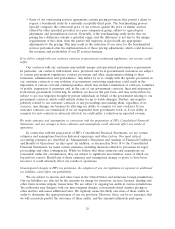HP 2010 Annual Report Download - page 30
Download and view the complete annual report
Please find page 30 of the 2010 HP annual report below. You can navigate through the pages in the report by either clicking on the pages listed below, or by using the keyword search tool below to find specific information within the annual report.Our revenue, cost of sales, and expenses may suffer if we cannot continue to license or enforce the
intellectual property rights on which our businesses depend or if third parties assert that we violate their
intellectual property rights.
We rely upon patent, copyright, trademark and trade secret laws in the United States, similar laws
in other countries, and agreements with our employees, customers, suppliers and other parties, to
establish and maintain intellectual property rights in the technology and products we sell, provide or
otherwise use in our operations. However, any of our direct or indirect intellectual property rights
could be challenged, invalidated or circumvented, or such intellectual property rights may not be
sufficient to permit us to take advantage of current market trends or otherwise to provide competitive
advantages, either of which could result in costly product redesign efforts, discontinuance of certain
product offerings or other competitive harm. Further, the laws of certain countries do not protect
proprietary rights to the same extent as the laws of the United States. Therefore, in certain jurisdictions
we may be unable to protect our proprietary technology adequately against unauthorized third-party
copying or use; this too could adversely affect our competitive position.
Because of the rapid pace of technological change in the information technology industry, much of
our business and many of our products rely on key technologies developed or licensed by third parties.
We may not be able to obtain or continue to obtain licenses and technologies from these third parties
at all or on reasonable terms, or such third parties may demand cross-licenses to our intellectual
property. In addition, it is possible that as a consequence of a merger or acquisition, third parties may
obtain licenses to some of our intellectual property rights or our business may be subject to certain
restrictions that were not in place prior to the transaction. Consequently, we may lose a competitive
advantage with respect to these intellectual property rights or we may be required to enter into costly
arrangements in order to terminate or limit these rights.
Third parties also may claim that we or customers indemnified by us are infringing upon their
intellectual property rights. For example, individuals and groups frequently purchase intellectual
property assets for the sole purpose of asserting claims of infringement and attempting to extract
settlements from large companies such as HP. The number of these claims has increased significantly in
recent periods and may continue to increase in the future. If we cannot or do not license the infringed
technology at all or on reasonable terms, or substitute similar technology from another source, our
operations could be adversely affected. Even if we believe that the claims are without merit, they can
be time-consuming and costly to defend and may divert management’s attention and resources away
from our business. Claims of intellectual property infringement also might require us to redesign
affected products, enter into costly settlement or license agreements, pay costly damage awards, or face
a temporary or permanent injunction prohibiting us from importing, marketing or selling certain of our
products. Even if we have an agreement to indemnify us against such costs, the indemnifying party may
be unable to uphold its contractual obligations to us.
Finally, our results of operations and cash flows have been and could continue to be affected in
certain periods and on an ongoing basis by the imposition, accrual and payment of copyright levies or
similar fees. In certain countries (primarily in Europe), proceedings are ongoing or have been
concluded involving HP in which groups representing copyright owners sought to impose upon and
collect from HP levies upon equipment (such as PCs, MFDs and printers) alleged to be copying devices
under applicable laws. Other such groups have also sought to modify existing levy schemes to increase
the amount of the levies that can be collected from HP. Other countries that have not imposed levies
on these types of devices are expected to extend existing levy schemes, and countries that do not
currently have levy schemes may decide to impose copyright levies on these types of devices. The total
amount of the copyright levies will depend on the types of products determined to be subject to the
levy, the number of units of those products sold during the period covered by the levy, and the per unit
fee for each type of product, all of which are affected by several factors, including the outcome of
ongoing litigation involving HP and other industry participants and possible action by the legislative
22
























